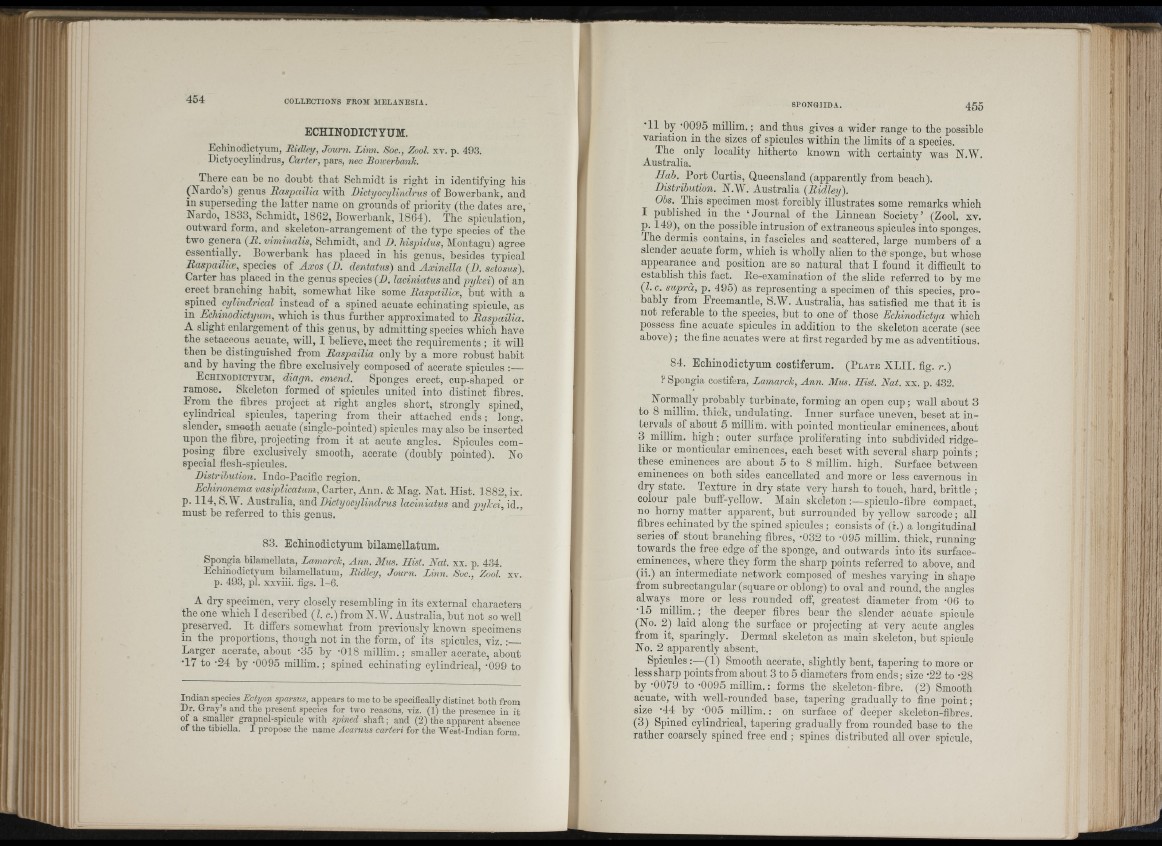
H
À t l
‘l î i i
B
g ;
i
¡•1.
ECHINODICTYUM.
Echinodictyuni, Ridley, Journ. Linn. Soc., Zool. xv. p. 493.
Dictyocylindrus, Carter, pars, nec Boieerhanh.
There can he no douhfc th at Schmidt is right in identifying his
(Nardo’s) genus Raspailia with Dictyocylindrus of Bowerbank, and
in superseding the latter name on grounds of priority (the dates are,
Nardo, 1833, Schmidt, 1862, Bowerhank, 1864). The spiculation,
outward form, and skeleton-arrangement of the type species of the
two genera (R. viminalis, Schmidt, and D. hisjridus, Montagu) agree
essentially. Bowerbank has placed in his genus, besides typical
Raspailice, species of A.vos (D. dentatus) and Axinella (B. setosus).
Carter has placed in the genus species (D. laciniatus and pyJcei) of an
erect branching habit, somewhat like some Raspailice, bnt with a
spined cylindrical instead of a spined acuate echinating spicule, as
in Ediinodictyum, which is thus further approximated to Raspailia.
A slight enlargement of this genus, by admitting species which have
the setaceous acuate, will, I believe, meet the requirements ; it will
then he distinguished from Raspailia only hy a more robust habit
and hy having the fibre exclusively composed of acerate spicules :—
E c h in o d ic t y u m , diagn. emend. Sponges erect, cup-shaped or
ramose. Skeleton formed of spicules united into distinct fibres.
From the fibres project at right angles short, strongly spined,
cylindrical spicules, tapering from their attached ends; long,
slender, smooth acuate (single-pointed) spicules may also be inserted
upon the fibre, projecting from it at acute angles. Spicules composing
fibre exclusively smooth, acerate (doubly pointed). No
special flesh-spicules.
Distribution. Indo-Pacific region.
Echinonema vasiplicatam. Carter, Ann. & Mag. Nat. Hist. 1882, ix.
p. 114, S.W. Australia, anG. Dictyocylindrus laciniatus an4 pylcci, id.,
must be referred to this gonus.
83. Echinodictyum hilamellatum.
Spongia biiamellata, Lamarck, Ann. Mus. Hist. Nat. xx. p. 434.
Echinodictyum bilamellatum, Ridley, Journ. Linn. Sue., Zool. xv.
p. 493, pi. xxviii. figs. 1-6.
A dry specimen, very closely resembling in its external characters
the one which I d.escrihed (I. c.) from N.W. Australia, hut not so well
preserved. I t differs somewhat from previously known specimens
in the proportions, though not in the form, of its spicules, v iz .:__
Larger acerate, about -35 by -018 millim.; smaller acerate, about
•17 to -24 by -0095 millim.; spined echinating cylindrical, -099 to
Indian species Ectyon sparsus, appears to me to be specifically distinct botb from
Dr. Gray’s and tbe present species for two reasons, viz. (1) tbe presence in it
of a small/ grapnel-spicule witb spined sbaft; and (2) tbe apparent absence
of tbe tibiella. I propose tbe name Acarnus carteri for tbe We*st-Indian form.
•11 by -0095 millim.; and thus gives a wider range to the possible
variation in the sizes of spicules within the limits of a species.
The only locality hitherto known with certainty was N.W.
Australia.
Hab. Port Curtis, Queensland (apparently from beach).
Distribution. N.W. Australia (Ridley).
Obs. This specimen most forcibly illustrates some remarks which
I published in the ‘ Journal of the Linnean Society’ (Zool. xv.
p. 149), on the possible intrusion of extraneous spicules into sponges,
ih e dermis contains, in fascicles and scattered, large numbers of a
slender acuate form, which is wholly alien to the sponge, but whose
appearance and position are so natural th at I found it difficult to
establish this fact. Re-examination of the slide referred to hy me
(I.e. supra, p. 495) as representing a specimen of this species, probably
from Ereemantle, S.W. Australia, has satisfied me that it is
not referable to the species, but to one of those Echinodictya which
possess fine acuate spicules in addition to the skeleton acerate (see
above); the fine acuates were at first regarded by me as adventitious.
84. Echinodictyum costiferum. ( P l a t e XL II. fig. r.)
? Spongia costifera, Lamarck, Ann. Mus. Hist. Nat. xx. p. 432.
Normally probably turbinate, forming an open cup; wall about 3
to 8 millim. thick, undulating. Inner surface uneven, beset at in tervals
of about 5 millim. with pointed monticular eminences, about
3 millim. high ; outer surface proliferating into subdivided ridgelike
or monticular eminences, each beset with several sharp points ;
these eminences aro about 5 to 8 millim. high. Surface between
eminences on both sides cancellated and more or less cavernous in
dry state. Texture in dry state very harsh to touch, hard, brittle ;
colour pale huff-yellow. Main skeleton ;—spiculo-fibre compact,
no horny matter apparent, but surrounded by yellow sarcode ; all
fibres echinated hy the spined spicules ; consists of (i.) a longitudinal
series of stout branching fibres, -032 to -095 millim. thick, running
towards the free edge of the sponge, and outwards into its siirface-
eminences, where they form the sharp points referred to above, and
(ii.) an intermediate network composed of meshes varying in shape
from suhrectangular (square or oblong) to oval and round, the angles
always more or less rounded off, greatest diameter from '06 to
•15 millim. ; the deeper fibres bear the slender acuate sjiicule
(No. 2) laid along the surface or projecting at very acute angles
from it, sparingly. Dermal skeleton as main skeleton, but spicule
No. 2 apparently absent.
Spicules :—( I) Smooth acerate, slightly bent, tapering to more or
less sharp points from about 3 to 5 diameters from ends; size -22 to -28
hy -0079 to -0095 millim. : forms the skeleton-fibre. (2) Smooth
acuate, with weU-rounded base, tapering gradually to fine point ;
size -44 by -005 millim. ; on surface of deeper skeleton-fibres.
(3) Spined cylindrical, tapering gradually from rounded base to the
rather coarsely spined free end ; spines distributed all over spicule,
i l
■i